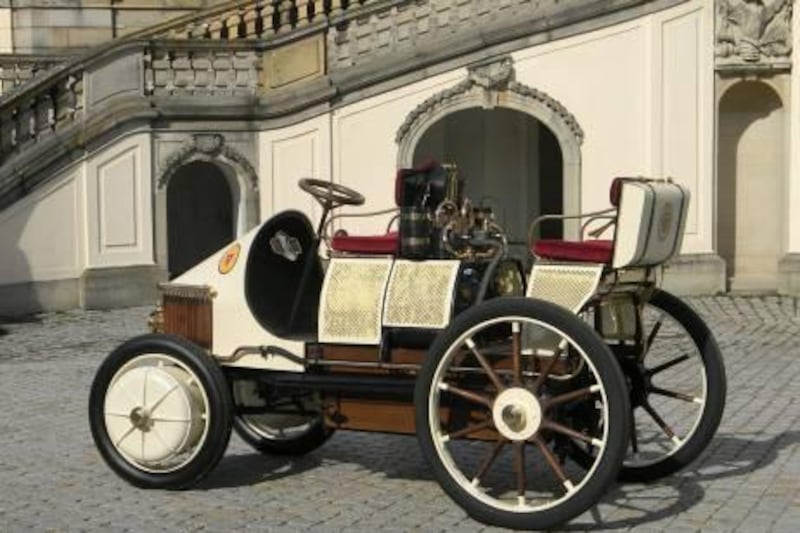The original doesn't exist anymore. It disappeared many years ago, its fate uncertain. But, in its day, the Semper Vivus (always alive) was as unique as anything plucked from the fertile imaginations of futurists - or prescient science-fiction writers such as Jules Verne. Unlike Verne's fanciful Nautilus, however, Semper Vivus was very real, the mechanical monstrosity a product of the equally prolific mind of a young Ferdinand Porsche, decades before he became associated with the sports cars that would bear his name.
However, a new Semper Vivus does exist; the result of a three-year, €600,000 (Dh3 million) project undertaken by the Porsche Museum, which had the vehicle - the world's first fully functional hybrid car - recreated. Semper Vivus was unveiled earlier this year at the Geneva Motor Show in commemoration to Porsche's hybrid technology - 111 years after Porsche's groundbreaking car moved under its own power.
The Porsche Museum engaged the talents of Hubert Drescher, a specialist in classic-car restoration. Working from one technical drawing and two grainy black-and-white photographs, Drescher had to reinvent Semper Vivus, doing so, he says, by trying "to think like Ferdinand Porsche". No easy task!
In 1900, the automobile was less than 15 years old. Petrol engines were waging a battle for supremacy with electric and steam propulsion. Porsche caught the electric bug early and began his career as an electrical engineer. In the late 1890s, he met Viennese coachbuilder Ludwig Lohner. In 1898, Lohner decided that electric propulsion was the way to proceed with the motorised carriage, enlisting 23-year-old Porsche to complete the development work for his line of chassis frames and bodies.
Around this time, Porsche developed a plan to integrate electric motors into a vehicle's wheels, eliminating the need for a power-consuming transmission and differential. Unveiled in 1900, the Lohner-Porsche Semper Vivus was a prototype based on an earlier electric car that had been entered for a hill-climb event. After conversion, it became a full hybrid.
Porsche combined his electric wheel hub motors with two internal combustion engines that had no mechanical connection with the driven axle. The engines drove an electrical generator that supplied power to both the wheel hub motors and the accumulators. To save weight and create enough space for the petrol engines, Porsche replaced the 74-battery accumulator with a smaller unit with 44 cells. To drive the two 2.5hp generators, he installed two water-cooled de Dion 3.5hp petrol engines at the centre of the chassis. These two engines ran separately.
Power flowed from the dynamo generators to the wheel hub motors, with excess current then passing to the batteries. The car's biggest problem was the weight of the wheel hubs - each weighed 270kg. Although Semper Vivus was only 70kg heavier than the hill-climb car, its total weight of 1,200kg was still too heavy for the soft rubber tyres. Further development would be needed. In recreating Semper Vivus, Drescher says that looking at the photos required him to try to figure out what certain things were. His attention to detail is such that he counted the nail holes in the car's body as well as the number of perforations in the panels covering many of the powertrain components. Amazingly, he actually found two de Dion engines of the type that powered the original - one in Strasbourg, France; the other in England.
This dedication to making Semper Vivus identical to the original has paid off - which is to say the car looks more than a century old - and handles like it.
I am perched about 1.5m off the ground in the driver's seat, about to steer it around the courtyard of Stuttgart's Schloss Solitude. Drescher's instructions to me are basic. There is a brake pedal. If the car feels like it's going too fast, use it. The three-speed gear shift is mounted - in the fashion of the day - externally. Drescher tells me to put the car in first gear only.
Theoretically, Semper Vivus has a top speed of about 40kph but the courtyard is a public place and I don't want to cause an international incident. About the steering - remember, the wheel hubs each weigh some 270kg - the upper-body workout is intense as it takes about eight turns to go lock to lock.
Semper Vivus is pretty much an oversized golf cart. It moves forward as silent as a thought, slowly building speed. It feels faster than it is; Drescher walks beside the car, ready to do something - I'm not sure what - in case of impending disaster. However, the brake pedal does work, in a fashion, and the steering steers, eventually.
The ride is all too brief - only a couple of hundred metres - but no less memorable in its brevity. I take away a couple of thoughts from the experience: First is that Ferdinand Porsche's genius was in full bloom well before he conceived the People's Car. Second, Semper Vivus was well ahead of its time, somewhat ironic considering all the fuss car makers create in their rush to build electric vehicles.
Oh, yeah, and Drescher is an artist.






